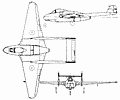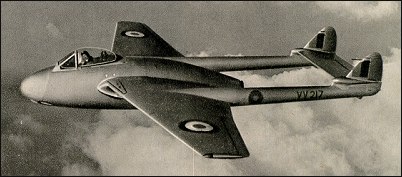|
| Perhaps one of the most interesting features of the de Havilland Vampire (as it became known) was the fact that its design began in 1941, not long after the first flight of the first prototype Mosquito.
Designed to satisfy Air Ministry Specification E.6/41 for an interceptor fighter to be powered by the then-developing turbojet engine, the twin-boom configuration of this aircraft was virtually dictated by the chosen power plant. This was because a single turbojet was to provide the total thrust; as this was very limited in early engines, it was necessary to ensure that power loss from the jet tailpipe was restricted to an absolute minimum by keeping the tailpipe as short as possible.
Borrowed from the Mosquito for the cockpit/ engine nacelle structure was the plywood-balsa-plywood sandwich form of construction. Like the Mosquito's fuselage, this was built in two half-shells which were joined top and bottom. The monoplane wing was an all-metal structure, incorporating the engine air intakes in the wing roots, split trailing-edge flaps, air brakes and ailerons. The pilot, seated well forward in the central nacelle beneath a three-piece canopy (replaced later by a bubble canopy), had a superb field of view.
Powered by a 12kN de Havilland Goblin turbojet, the prototype Vampire flew for the first time on 20 September 1943. The first production F.1 Vampire made its first flight on 20 April 1945 powered by the same engine as the prototype, as were the next 39 aircraft. Subsequent F.1 had 13.8kN Goblin Gn.2 engines. Entering service too late to make a contribution to World War II, Vampires began to equip RAF squadrons in mid-1946 and were the second type of jet fighter supplied to it.
Subsequent variants included the F.3 with increased internal fuel capacity and provisions for auxiliary tanks: six of these fighters were the first RAF jet-powered aircraft to achieve a flight across the North Atlantic. The FB.5 close-support fighter/bomber was introduced in 1949 with reduced wing span and long-stroke landing gear to cater for higher landing weights.
FB.9 with more power and improved equipment for operation in tropical conditions entered service with the Far East and Middle East Air Forces in 1952; these were the last RAF single-seat variants. A total of 95 two-seat NF.10 Vampire night-fighters also served in an interim capacity with the RAF from 1951, pending the introduction of Meteor and Venom night fighters.
The last major variant was the Vampire T.11 two-seat trainer, over 800 of which were built. The Royal Navy had a small number of F.20 Sea Vampires, generally similar to the RAF's FB.5, and 74 T.22 two-seat trainers derived from the T.11.
 | A three-view drawing (1683 x 1063) |
| CREW | 1 |
| ENGINE | 1 x DH "Goblin D.Gu.2", 13.7kN |
| WEIGHTS |
| Take-off weight | 3890 kg | 8576 lb |
| Empty weight | 2890 kg | 6371 lb |
| DIMENSIONS |
| Wingspan | 12.2 m | 40 ft 0 in |
| Length | 9.4 m | 31 ft 10 in |
| Height | 2.7 m | 9 ft 10 in |
| Wing area | 24.7 m2 | 265.87 sq ft |
| PERFORMANCE |
| Max. speed | 869 km/h | 540 mph |
| Range w/max payload | 1175 km | 730 miles |
| ARMAMENT | 4 x 20mm cannons |
| DavidC, e-mail, 09.08.2015 06:41 Can anyone tell me the airfoil number or profile information for the Vampire? reply | | Roman_013, e-mail, 22.07.2015 01:47 Dear pilots, I am very interested in this aircraft, and I have a question for you.the vampire and venom have guns that are located very low in the fuselage. It seems to me that the recoil of this guns could cause a nose-down pitching during shooting. Can you please confirm or deny this thought? reply | | Derek Horsey, e-mail, 30.01.2015 18:27 I was at Oakington from 1954-6 as an ATC Operations clerk and was fortunate to get two rides in the T11 one at night. These were, to us Ops Clerks, fast for their training I wold think. The fun was their use at our satalite airfield Graveley when they used to come up from the valley to surprise us ops clerks in the caravan. Don't know if David Campbell was the U.S.Office rat the time but we did have one U.S.Officer who attempted to teach us baseball on Wednesday afternoons sports time. Derek Horsey reply | | Trevor Webb, e-mail, 30.10.2014 13:54 The gap between the Sea Vampires Mks 20 and 23 was filled by the Mk 21 which was a variant that took off with a droppable undercarriage and landed on a strengthened belly on a rubberised deck. reply | |
| | philip worth, e-mail, 30.12.2013 13:10 hello.
i wonder if any one could help me identify a vampire. i have a picture given to me by a mr coombes who was based at chivenor 1947-? of a vampire , but its an in motion picture and the boom numbers are slightly blurred.
i read them as wg868 would this be right and what model would it be.
i would say all over silver, with fuel tanks no markings under /on front. many thanks philip worth. reply |
| Bill Downie, e-mail, 09.09.2013 22:58 Like Brian Moore (comment below) I served at No. 4 FTS RAF Middleton St. George from 1954-1956 as an Air Wireless Mech. and my first flight ever was in a T.11 from MSG to Turnhouse, Edinburgh for a "48". Happy Days!!! reply | | Bill Downie, e-mail, 09.09.2013 22:57 Like Brian Moore (comment below) I served at No. 4 FTS RAF Middleton St. George from 1954-1956 as an Air Wireless Mech. and my first flight ever was in a T.11 from MSG to Turnhouse, Edinburgh for a "48". Happy Days!!! reply | | Sandy, e-mail, 31.12.2012 18:31 Did the Vampire fighter ever shoot down another aircraft? reply | | David Kluey, e-mail, 06.12.2012 16:50 Am looking for 1 or 2 nose wheel tyres for a T-11 Vamp. reply | | Neil McMenamin, e-mail, 01.12.2012 07:05 I was an SAC engine mech. from 1952-55 in 145 Squadron at Celle. We had all Vamps until about 1953-4 when re-equipped with Venoms. Any pilot over about 6ft2 had to be checked out with lifting tackle to check if they could eject without losing their kneecaps on the gunsight. Both aircraft very low which made oil checks etc in the winter snow uncomfortable. Venom welcome to fitters as it had cartridge-start engine, no trolley-ac required. reply | | Brian Moore, e-mail, 04.09.2012 01:32 1954-1956 worked in air traffic control Middleton St George as Operations clerk very fortunate to have three flights in vampire T 11-what a fantastic experience reply | | David Campbell, e-mail, 02.05.2011 02:36 I was a USAF exchange pilot at Oakington with 206AFS and 5FTS and commanded the Vampire Standardization Sq. I have flown all the american fighter aircraft from the P-40 to F-4. The Vampire was the most enjoyable airplane I ever flew It was pure pleasure every time i got in it. reply | | Fred Bowyer, e-mail, 26.03.2011 09:02 I was an engine mechanic on 23 squadron 1952-55 NF10s Never
see them mentioned in any publications these days. It either the single seaters or sea venoms. reply | | John Quigley, e-mail, 04.03.2011 09:55 I was doing my National Service at Canberra in 1952 when the first Vampire in Australia flew in. Being in Signals the buzz going around was that the aircrafarrived before the Air Traffic Movement did...if my memory serves me.
I still have some photos of the first jet in Australia...and I was one of the first
to see it! Made my Nasho experience worth it. reply | |
| | Les Stothard, e-mail, 07.02.2011 22:31 Hi during nat. service i was on 145 squadron as a airframe mech.We work on venoms refueling and doing safty checks before each flight Some times we had flights in a dual seatera but i cannot rember if a vampire or a Venom. any one remember Les Sothard reply | | Les Stothard, e-mail, 07.02.2011 22:31 Hi during nat. service i was on 145 squadron as a airframe mech.We work on venoms refueling and doing safty checks before each flight Some times we had flights in a dual seatera but i cannot rember if a vampire or a Venom. any one remember Les Sothard reply | | Les Neaves, e-mail, 29.11.2010 23:14 I flew the Vamp. with 145 Squadron, 2nd TAF, at R.A.F. Celle, 1953 to 1956. During that time we were re-equipt with Venoms, which were the new version of the Vampire.
The venom hsd wing tip tanks which increased its range.
I remember training on Meteors at R.A.F. Oakington and was posted to R.A.F. Pembrey to 230 O.C.U. when I arrived at thev flights they took me out to a Vampire sat me in it, showed me the controls and said ''off you go and don't bend it. It turned out to be a lovely aircraft to fly. reply | | Lewis Johns, e-mail, 12.05.2010 00:00 I progressed to the Vampire T11 from the Provost at RAF Linton on Ouse in 1958; sadly the FB 5s and 9s were taken out of service during my time and we completed our training in the T11s. Halcyon days!! reply | | David, e-mail, 18.02.2010 08:29 I did my U.K. jet training and gunnery school on the Vampire 5. Then flew Venom FB1's and 4's in the Middle East from 1955-1957. A good air to air gunnery, rocketing and dive bombing platform. reply | | Harry Walker, e-mail, 06.02.2010 23:36 I wholeheartedly agree with Richard Stobbart. The Vampire is the forgotten jet fighter yet together with the Meteor it brought the RAF into the jet era, likewise the later Venom.It would appear that everyone thinks that the RAF went from Spitfires and Hurricanes to Hunters It has even taken Corgi years to finally get around to producing a diecast model of the Vampire, but still no Venom reply |
|
Do you have any comments?
|
| 
COMPANY
PROFILE
All the World's Rotorcraft
|








WG868 DH Vampire FB9
d /d 26 /11 /1951, sold as scrap 20 /12 /1957 at No.10 MU Hullavington
reply